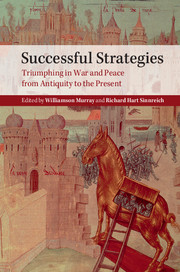Book contents
- Frontmatter
- Dedication
- Contents
- List of tables and map
- List of contributors
- Acknowledgments
- Introduction
- 1 The strategic thought of Themistocles
- 2 The grand strategy of the Roman Empire
- 3 Giraldus Cambrensis, Edward I, and the conquest of Wales
- 4 Creating the British way of war: English strategy in the War of the Spanish Succession
- 5 Failed, broken, or galvanized?
- 6 Victory by trial and error: Britain’s struggle against Napoleon
- 7 The strategy of Lincoln and Grant
- 8 Bismarckian strategic policy, 1871–1890
- 9 Dowding and the British strategy of air defense 1936–1940
- 10 US naval strategy and Japan
- 11 US grand strategy in the Second World War
- 12 American grand strategy and the unfolding of the Cold War 1945–1961
- 13 The Reagan administration’s strategy toward the Soviet Union
- Afterword
- Index
- References
Afterword
Published online by Cambridge University Press: 05 June 2014
- Frontmatter
- Dedication
- Contents
- List of tables and map
- List of contributors
- Acknowledgments
- Introduction
- 1 The strategic thought of Themistocles
- 2 The grand strategy of the Roman Empire
- 3 Giraldus Cambrensis, Edward I, and the conquest of Wales
- 4 Creating the British way of war: English strategy in the War of the Spanish Succession
- 5 Failed, broken, or galvanized?
- 6 Victory by trial and error: Britain’s struggle against Napoleon
- 7 The strategy of Lincoln and Grant
- 8 Bismarckian strategic policy, 1871–1890
- 9 Dowding and the British strategy of air defense 1936–1940
- 10 US naval strategy and Japan
- 11 US grand strategy in the Second World War
- 12 American grand strategy and the unfolding of the Cold War 1945–1961
- 13 The Reagan administration’s strategy toward the Soviet Union
- Afterword
- Index
- References
Summary
The thirteen essays in this volume originated in one explicit question and one implied belief. The question is how a national government, or an alliance, formulates and executes an effective military strategy. The belief is that doing so materially improves the likelihood of prosecuting war to a successful conclusion, or, better still, of averting it altogether. Both question and belief reflect widespread agreement among contemporary observers of US national security policy that, since the end of the Cold War, the US has been bereft of a coherent defense strategy, thereby incurring penalties ranging from the misallocation of defense resources to counterproductive military commitments. As the project’s sponsor noted, “There is little attention paid to assessing the state of the competition, or evaluating strengths and weaknesses in ourselves or our potential opponents, and still less effort to develop genuine strategies that exploit the enduring strengths we bring to the competition.” In his Introduction, Williamson Murray points out that official declarations of strategic intention abound. But the conviction persists that, however useful they may be as wish lists, they have been much less useful in disciplining resource and commitment decisions. The cases examined here seek to illuminate how others – including we ourselves – previously have done better.
- Type
- Chapter
- Information
- Successful StrategiesTriumphing in War and Peace from Antiquity to the Present, pp. 432 - 447Publisher: Cambridge University PressPrint publication year: 2014



